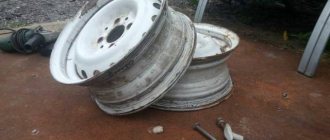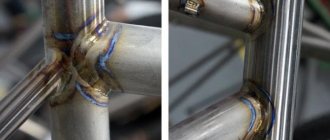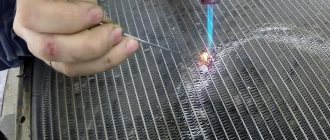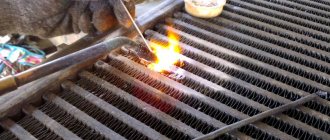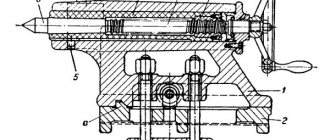For vehicles traveling on Russian roads, hitting a wheel on a pothole is a common thing. Car owners know that every such hit is fraught with damage to the support rim. Driving with damaged wheels is unsafe. Cast and forged wheels are made from two alloys:
- aluminum-silicon contain from 7 to 12% and magnesium;
- AlSiMg alloy is more ductile, has been used since the 80s, and contains from 11 to 15% magnesium.
Pure aluminum is not currently used. To restore the integrity of the metal, welding of disks with argon is usually used. Many service stations do this kind of work.
Repairs can be carried out in the garage. It is permissible to weld a cast disk without a protective atmosphere using the electric arc method. The connection is not very reliable, but further destruction of the aluminum part by electrode surfacing can be stopped.
Types of damage
Alloy wheels are deservedly popular among car owners. Despite all the advantages they have, such as low weight and good heat dissipation from the brakes, these products have one significant drawback - the possibility of damage when receiving a strong blow. We must always remember that a damaged disk is a serious prerequisite for an emergency situation.
One of the reasons why damage can occur lies in the technology of its production. The thing is that these discs are produced using casting. This is why the discs become brittle and lack sufficient ductility.
As a result of this, even when receiving not the strongest impacts, cracks and chips may form on the disk. This leads to a change in the geometry of the disk and it begins to hit. After this, the car begins to “yaw” and can easily lose control, thereby creating the preconditions for a traffic accident.
The car owner must clearly understand that using a disc with some defects on a car creates a real danger for all road users, and first of all for the car owner and those who are next to him inside the car.
Damaged alloy wheel
The most common defects in alloy wheels are:
- cracks;
- displacement along the axis and radius;
- chips;
- damage to the applied coating.
Damage to disks occurs for the following reasons:
- Defects in the road surface. When a wheel falls into a hole or crack, it receives a strong blow, leading to a certain defect. Cars using low-profile tires will often suffer such damage.
- The wheel may start to spin after hitting a curb or falling into a hole. After this, a dent appears on the surface of the disk.
- Axial runout, popularly called figure eight, begins to appear after a side impact received in a collision with an obstacle, for example, a car moving in a parallel course.
- The damaged coating that is applied to the surface of the disk does not lead to obvious damage, but after a while corrosion begins to actively develop underneath it and it will be too late to repair it.
What kind of damage to alloy wheels cannot be repaired?
Before contacting a workshop that repairs alloy wheels, the car owner must know which defects cannot be repaired. What is this for? The thing is that sometimes unscrupulous craftsmen, taking advantage of the fact that the owner of the car is not always oriented in this matter, try to extract additional benefits by imposing services on the consumer that he does not need. Which, by the way, can lead to irreparable consequences.
Major changes to the geometry of the cast wheel
Even highly professional craftsmen will not undertake to correct the following defects:
- large cracks and chips;
- defects in the hub area;
- critical distortion of geometry.
Terms
In Russian-language technical literature, especially on the Internet, the term “wheels” is usually used. In English-language regulatory and technical literature, wheel rims are called “wheels”, that is, “wheels”. Each wheel has a rim, that is, the part on which the tire is mounted. The “disc” is the element of the wheel that connects the rim to the vehicle’s axle. Steel truck wheels usually do not have a hub, but are attached directly to the axle through the disc. Therefore, they are called “disk wheels” [1, 2]. Aluminum wheels often have “spokes” instead of a disc, which go into a “hub”. The hub is attached to the axle of the car. Note that GOST R 50511-93 [3] uses the international terms “wheels” and “disc wheels”.
Below, to avoid confusion, we will use the terms “wheels,” “disc wheels,” and “rims” interchangeably.
Selecting welding type and electrode
One of the most effective repair methods is argon welding of alloy wheels. To perform this work, you will need a welding machine; recently, inverter machines are increasingly being used as a welding current generator. Their advantages are obvious; with minimal size and weight parameters, these devices are capable of generating the current necessary to perform welding work on cast wheels.
Argon welding of cast wheels
Practice shows that manual welding under shielding gas is not the best solution, so semi-automatic welding is often used. That is, the welding generator must be equipped with a device for supplying welding material and gas.
Welding magnesium discs
Welding of disks made of magnesium alloys is performed using a tungsten electrode. It is performed in a protective gas environment. For this purpose, first grade argon is used. Sometimes it is acceptable to use consumable electrode welding. An alternator must be used for this welding.
Before welding, it is necessary to prepare the edges of the area being restored. But, if the metal being welded is less than 3 mm, then the edges do not need to be cut. For larger thicknesses, preparation must be made in a V shape. Welding must be performed at increased speed. The speed mode guarantees to minimize the effect of the thermal effect of welding on the metal.
Argon arc welding of disks made of magnesium alloys
The arc should not exceed 1 - 1.5 mm. This allows you to destroy the oxide film that appears on the surface of the part and guarantees high quality welds.
Welding tips
Experienced welders give the following advice when carrying out work:
- To prevent abrasive from getting into the seam, it is advisable to cut the part with a milling cutter.
- If you cannot weld the crack in one approach, then you need to cut out the root of the seam from the back side.
- It is better to place copper or stainless steel linings on the reverse side.
- In order to reduce the stress on the part, it is necessary to heat the welded area to approximately 250-300 degrees . Laundry soap will help determine the temperature. To do this, you need to run a bar of soap over the disk and heat it. When the mark turns brown, the temperature on the disk is 250 degrees , and when it turns black, it is 300 degrees .
The procedure for carrying out repair work
To correct damage to alloy wheels, it is necessary to involve specialists who repair them. In addition, specialized equipment and tools will be in demand. So, you can only restore the protective coating with your own hands.
In the repair shop, approximately the following list of work will be done.
Preparation - any disk must undergo an inspection before starting work. To perform this operation, it must be cleaned of dirt and only then will all damage become noticeable.
If cracks are detected, the disc will have to be sent for welding. Welding of cast wheels is performed using equipment that allows work to be performed under the protection of inert gases. To repair discs made of aluminum, electrodes of the AG brand are used; for discs made of magnesium alloys, it is necessary to use electrodes of the AMG brand.
After all the cracks have been welded, the surface of the disk must be cleaned of welding marks. If necessary, special equipment must be used.
After cleaning the disk, its geometric parameters are checked. To do this, the finished disk is installed in a special cartridge. To restore geometric parameters, a hydraulic cylinder equipped with special attachments is used. In this way, beats and, of course, geometric parameters are eliminated.
After the defects have been eliminated, the disc will be sanded, degreased and sent for painting. Coatings that are based on epoxy resin are often used for coating.
The very last operation is balancing.
By the way, some experts strongly recommend installing disks on the rear axle.
Preparing the disc for welding work
Preparing a cast wheel for repair is not much different from what is done to work with other parts made of similar materials.
Preparing the crack edge for welding
That is, it is necessary to prepare the edges of the crack for welding. The size of the bevels that must be made depends on the thickness of the material to be welded.
Introduction
The topic of using welding in the repair of aluminum car wheels remains very relevant. On the popular forum of the Chipmaker website - a site for craftsmen working with metals, amateurs and professionals, such a discussion has not subsided for about 8 years (Welding rims). Similar discussions are taking place in foreign forums.
Below we present information that explains the features and difficulties of repair welding of aluminum rims:
- regulations;
- wheel manufacturing technologies;
- aluminum alloys, which are used in wheel rims;
- heat treatment, which is applied to aluminum rims;
- welding methods used when welding aluminum wheels;
- heat affected zone when welding aluminum.
This information does not purport to be a complete statement of the topic covered and is not intended to be instructions for welding aluminum wheels.
Welding of aluminum products
To obtain a high-quality weld on damaged aluminum disks, welding in a shielding gas environment using tungsten electrodes is used.
Before you start welding the damaged area on a disk made of aluminum, you need to prepare the area. To do this, it is necessary to remove dirt and traces of oil from its surface.
You can use almost any solvent for this. Cutting the edges of the damaged area is necessary when the metal thickness is at least 4 mm. In order to perform the correct cutting, it makes sense to use hand-held power tools.
Necessary equipment
For welding work to repair a cast wheel, you will need the following set of equipment and devices:
- A welding current generator equipped with a wire feeder or a torch equipped with a non-consumable electrode.
- A steel cylinder designed to store gas.
- Individual protection means.
Foreign regulatory documents
Wheel rims are highly loaded elements of a car, on which its safety largely depends. Therefore, leading manufacturers of cars and wheel rims do not allow any repair work to be performed on them, including repair welding.
The ISO 14400 standard explicitly states that repairs to wheel rims by welding should not be carried out, as this may introduce additional stresses into critical areas [1]. The organization EUWA (Association of European Wheel Manufactures) - the Association of European Wheel Manufacturers - strictly prohibits the repair of damaged rims and disks of automobile wheels using heating, welding or adding any additional material [4].
At the same time, the regional regulatory document of the Canadian province of British Columbia - rules for welding repair of aluminum wheel rims - allows for the limited use of welding for the repair of wheel rims [5].



